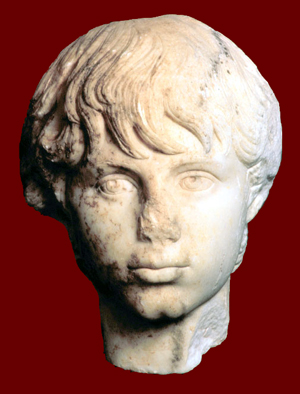Greek and Roman Gallery
Like the objects in the exhibition Cavafy’s World, certain items on permanent display in the Kelsey Museum galleries also resonate with some of Constantine Cavafy’s poems. Three such examples from the Greek and Roman Gallery are offered here.
Marble sarcophagus with a scene of Bacchic revel
Roman, 2nd century AD
Kelsey Museum 1981.3.1
 |
|
The Retinue of Dionysos
Damon the craftsman (none better
in the Peloponnese) is giving the last touches
to his Retinue of Dionysos
carved in Parian marble: the god leading
in divine glory, with power in his stride;
after him, Intemperance; and beside Intemperance,
Intoxication pours out the satyrs’ wine
from an amphora wreathed in ivy;
near them, Sweetwine, the delicate,
eyes half-closed, soporific;
and behind come the singers
Tunemaker and Melody and Reveller—
the last holding the honored processional torch
which he never lets die—and then Ceremony, so modest.
Damon carves all these. And as he works
his thoughts turn now and then
to the fee he’s going to receive
from the king of Syracuse:
three talents, a large sum.
Adding this to what he has already,
he’ll live grandly from now on, like a rich man,
and—think of it—he’ll be able to go into politics:
he too in the Senate, he too in the Agora.
Trans. Edmund Keeley and Philip Sherrard
|
|
|
|
Pentelic marble portrait of the youth Polydeukion
Roman, ca. AD 150
Kelsey Museum 1974.6.1
 |
|
I’ve Looked So Much . . . .
I’ve looked on beauty so much
that my vision overflows with it.
The body’s lines. Red lips. Sensual limbs.
Hair as though stolen from Greek statues,
always lovely, even uncombed,
and falling slightly over pale foreheads.
Figures of love, as my poetry desired them
. . . . in the nights when I was young,
encountered secretly in those nights.
Trans. Edmund Keeley and Philip Sherrard
|
|
|
In Alexandria, 31 BC
From his village near the outskirts of town,
still dust-covered from the journey in,
the peddler arrives. And “Incense!” “Gum!”
“The best olive oil!” “Perfume for your hair!”
he hawks through the streets. But with all the hubbub,
the music, the parades, who can hear him?
The crowd shoves him, drags him along, knocks him around.
And when he asks, now totally confused, “What’s going on here?”
someone tosses him too the huge palace lie:
that Antony is winning in Greece.
Trans. Edmund Keeley and Philip Sherrard
|
|
|
Marble portrait of Augustus,
who defeated Antony at the Battle of Actium in 31 BC to become the first emperor of Rome
Roman, 27 BC–AD 14
Kelsey Museum 1975.1.1
 |
|
|
|